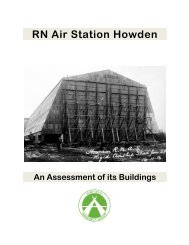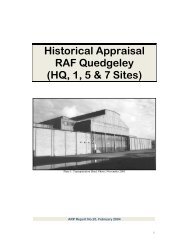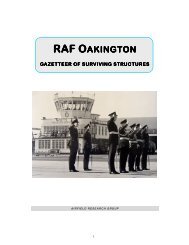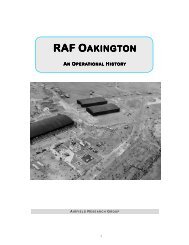RNAS Lee - The Airfield Research Group
RNAS Lee - The Airfield Research Group
RNAS Lee - The Airfield Research Group
Create successful ePaper yourself
Turn your PDF publications into a flip-book with our unique Google optimized e-Paper software.
3.3 RAF RAF RAF Expansion Expansion Period Period 1934 1934-1939<br />
1934 1939<br />
While all of this reconstruction work was taking place under the first building contract,<br />
rearmament plans had been announced by Parliament involving a major expansion of the RAF.<br />
A number of schemes were formulated between 1934 and 1939 but only five were actually<br />
passed by the Cabinet (‘A’,’C’,’F’,’L’ and ‘M’). Under Schemes ‘A’ and ‘F’, the construction of new<br />
buildings and extensions to existing structures commenced at <strong>Lee</strong> under the second building<br />
contract of 1935. This contract involved the following:<br />
• Kingston Villa was extended to become a W/T signals and lecture room.<br />
• Norbury House was also extended to include an armament instruction classroom which<br />
became the station armoury.<br />
• New ration store.<br />
• New laundry.<br />
• Watch office with tower built in front of the type ‘A’ aeroplane shed.<br />
• A 100,000 gallon water reservoir was provided for station use.<br />
• Type ‘C’ aircraft shed erected instead of the second type ‘A’.<br />
• Intake sub-station.<br />
• New institute.<br />
Many buildings designed for the last two schemes (‘L’ and ‘M’) were not proceeded with at <strong>Lee</strong>on-Solent<br />
as in May 1939, the station once again came under Admiralty control. <strong>The</strong>refore Air<br />
Ministry designs such as the central heating station, decontamination centre and the annexe to<br />
station sick quarters were not built here. <strong>The</strong> Admiralty did however build two, three-storey<br />
barrack blocks with an ‘H’-shaped plan-form and these were based on the RAF two-storey<br />
version.<br />
3.4 3.4 World WWar<br />
W<br />
ar Two 1939 1939-1945<br />
1939<br />
1945<br />
<strong>Lee</strong>-on-Solent was one of the first stations to have hard surface runways and the construction of<br />
these along the centre line of two flight strips started in May 1939. One of these, the east-west<br />
(50 yards wide and 750 yards long) runway (heading 13-31) only had restricted use (Kingsland<br />
House, occupied in the late 1930s by Percy Marsh Whettam - was on the approach). Eventually<br />
the runway had to be abandoned when it was proposed to extend the hutted North Camp in 1941.<br />
<strong>The</strong> other runway on a heading of 24-06, had a length of 3,000ft. Skirting around the aerodrome<br />
to connect with runways, hangars and aircraft blast pens, is a 50ft wide perimeter track.<br />
By the beginning of 1942 land to the east of Milville Lane was purchased for the construction of a<br />
third runway on a heading of 18-36. <strong>The</strong> abandoned runway was rebuilt and extended further<br />
east on a new heading (11-29) to avoid Kingslands House and the new hutted camp (East<br />
Camp).<br />
<strong>The</strong> final runway lengths were as follows:<br />
• Runway 18-35: 3,000ft<br />
• Runway 24-06: 4,290ft<br />
• Runway 11-29: 3,300ft<br />
It is interesting to note that, with the introduction of the Defence Regulations made under the<br />
Emergency Powers (Defence) Act, 1939, the difficulties of obtaining possession only with the<br />
agreement of owners were removed and now permitted the taking of immediate possession of<br />
land and buildings. This may be the reason why Kinglands House was retained even though it<br />
was in such a dangerous position close to runway 31. <strong>The</strong> building of a hutted camp on a site<br />
that was restricted in area only reinforced its retention - the only option open was to rebuild the<br />
runway on a new heading. A Highway Closing Order was also served on Drake Road, Grenville<br />
Road and Tennyson Road. <strong>The</strong> surviving properties which had until now been in private hands,<br />
were finally requisitioned. None of these were demolished and all were retained within the<br />
development of the station.<br />
<strong>The</strong> first four Bellman transportable aeroplane sheds were erected in 1939 / 1940 on a site close<br />
to the north-west section of perimeter track. <strong>The</strong>se were not the standard RAF Bellman sheds<br />
19






